What is Mutation?
Mutation is a change in the DNA sequence of an organism. It can occur due to various factors such as errors during DNA replication, exposure to mutagenic agents (e.g. radiation, chemicals), or environmental factors.
Types of Mutations
There are several types of mutations:
- Point Mutation: A single nucleotide base is replaced with another, which can result in different amino acids being coded for in the protein synthesis process.
- Insertion: An extra nucleotide base is added into the DNA sequence.
- Deletion: A nucleotide base is removed from the DNA sequence.
- Frameshift Mutation: Insertion or deletion of nucleotides causes a shift in the reading frame, leading to a completely different protein being produced.
- Chromosomal Mutation: Involves changes in the structure or number of whole chromosomes, such as translocations, inversions, or duplications.
Effects of Mutation
Mutations can have various effects on an organism:
- Neutral: Some mutations have no discernible effect on the organism's phenotype.
- Beneficial: In rare cases, mutations can confer advantages such as resistance to diseases or environmental conditions.
- Deleterious: Many mutations are harmful and can lead to genetic disorders or diseases.
Importance of Mutations
Mutations are the raw material for evolution, providing genetic diversity upon which natural selection can act. They are also important in the fields of genetic research and biotechnology.
Study Guide
When studying mutations, it's important to understand the following key points:
- The different types of mutations and their specific effects on the DNA sequence.
- How mutations can lead to genetic diseases or disorders.
- The role of mutations in driving evolutionary change and adaptation.
- The impact of mutagenic agents on the frequency of mutations in populations.
- Applications of mutations in biotechnology and genetic engineering.
It's also helpful to practice analyzing and interpreting examples of mutations in DNA sequences, and understand the methods used to study and detect mutations.
[Mutation] Related Worksheets and Study Guides:
.◂Biology Worksheets and Study Guides High School. The Study of Heredity
Worksheet/Answer key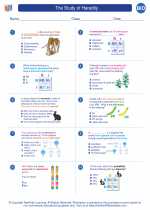 The Study of Heredity
The Study of Heredity  Worksheet/Answer key
Worksheet/Answer key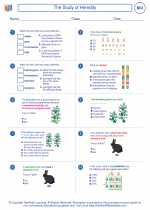 The Study of Heredity
The Study of Heredity  Vocabulary/Answer key
Vocabulary/Answer key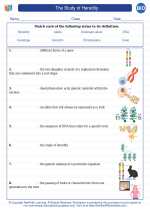 The Study of Heredity
The Study of Heredity  Vocabulary/Answer key
Vocabulary/Answer key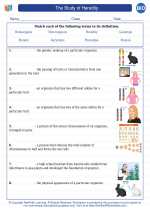 The Study of Heredity
The Study of Heredity  Vocabulary/Answer key
Vocabulary/Answer key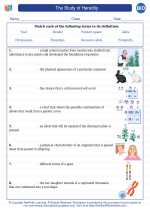 The Study of Heredity
The Study of Heredity 

 Worksheet/Answer key
Worksheet/Answer key
 Vocabulary/Answer key
Vocabulary/Answer key
 Vocabulary/Answer key
Vocabulary/Answer key
 Vocabulary/Answer key
Vocabulary/Answer key

The resources above cover the following skills:
Skills And Processes: The student will demonstrate ways of thinking and acting inherent in the practice of science. The student will use the language and instruments of science to collect, organize, interpret, calculate, and communicate information.
The student will pose scientific questions and suggest investigative approaches to provide answers to questions.
The student will test a working hypothesis. (NTB)
The student will demonstrate that data analysis is a vital aspect of the process of scientific inquiry and communication.
The student will organize data appropriately using techniques such as tables, graphs, and webs (for graphs: axes labeled with appropriate quantities, appropriate units on axes, axes labeled with appropriate intervals, independent and dependent variables on correct axes, appropriate title).
The student will use models and computer simulations to extend his/her understanding of scientific concepts. (NTB)
The student will use appropriate methods for communicating in writing and orally the processes and results of scientific investigation.
The student will explain scientific concepts and processes through drawing, writing, and/or oral communication.
The student will use computers and/or graphing calculators to produce the visual materials (tables, graphs, and spreadsheets) that will be used for communicating results. (NTB)
The student will create and/or interpret graphics. (scale drawings, photographs, digital images, field of view, etc.)
Concepts Of Biology: The student will demonstrate the ability to use scientific skills and processes (Core Learning Goal 1) and major biological concepts to explain the uniqueness and interdependence of living organisms, their interactions with the environment, and the continuation of life on earth.
The student will be able to explain the correlation between the structure and function of biologically important molecules and their relationship to cell processes.
The student will be able to describe the unique characteristics of chemical substances and macromolecules utilized by living systems.
The student will analyze how traits are inherited and passed on from one generation to another.
The student will illustrate and explain how expressed traits are passed from parent to offspring.
The student will explain how a genetic trait is determined by the code in a DNA molecule.
The student will explain the mechanism of evolutionary change.
The student will explain how new traits may result from new combinations of existing genes or from mutations of genes in reproductive cells within a population.